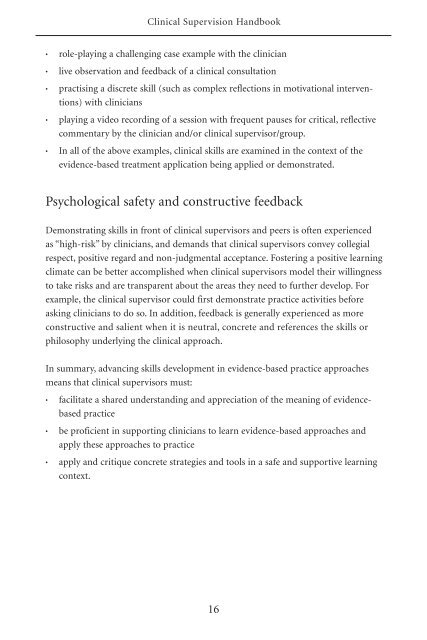Clinical Supervision Handbook - CAMH Knowledge Exchange ..
Create successful ePaper yourself
Turn your PDF publications into a flip-book with our unique Google optimized e-Paper software.
<strong>Clinical</strong> <strong>Supervision</strong> <strong>Handbook</strong><br />
• role-playing a challenging case example with the clinician<br />
• live observation and feedback of a clinical consultation<br />
• practising a discrete skill (such as complex reflections in motivational interventions)<br />
with clinicians<br />
• playing a video recording of a session with frequent pauses for critical, reflective<br />
commentary by the clinician and/or clinical supervisor/group.<br />
• In all of the above examples, clinical skills are examined in the context of the<br />
evidence-based treatment application being applied or demonstrated.<br />
Psychological safety and constructive feedback<br />
Demonstrating skills in front of clinical supervisors and peers is often experienced<br />
as “high-risk” by clinicians, and demands that clinical supervisors convey collegial<br />
respect, positive regard and non-judgmental acceptance. Fostering a positive learning<br />
climate can be better accomplished when clinical supervisors model their willingness<br />
to take risks and are transparent about the areas they need to further develop. For<br />
example, the clinical supervisor could first demonstrate practice activities before<br />
asking clinicians to do so. In addition, feedback is generally experienced as more<br />
constructive and salient when it is neutral, concrete and references the skills or<br />
philosophy underlying the clinical approach.<br />
In summary, advancing skills development in evidence-based practice approaches<br />
means that clinical supervisors must:<br />
• facilitate a shared understanding and appreciation of the meaning of evidencebased<br />
practice<br />
• be proficient in supporting clinicians to learn evidence-based approaches and<br />
apply these approaches to practice<br />
• apply and critique concrete strategies and tools in a safe and supportive learning<br />
context.<br />
16


